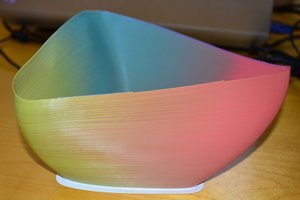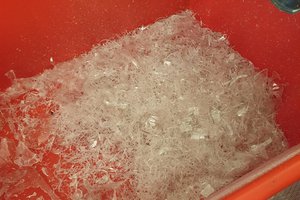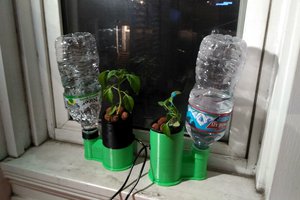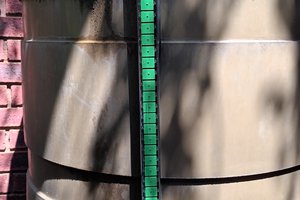Now, I know the state of the art for hobbyists currently is using a crock pot or similar - basically self heating pressurized kettle - to boil and gasify acetone for post-processing the raw 3D ABS print. Acetone, of course, is highly flammable, poisonous to breathe, and potentially explosive in certain forms, so this needs to be carried out outside and with much care. There's also the issue I don't currently own a crock pot; though one is easy and affordable enough to get I suppose.
On the background of the first picture, the blue is as of yet untreated, the black plastic has simply been dipped in acetone. One major problem with this approach can be seen: the acetone pools where it flows, causing uneven effect on the bottom, and in this case after unwisely trying if it'd solidified with fingertip and discovering those pools can take a long time to dry inside out, even fingerprints.
But can we do better than any of this? Yes, yes I think we can. I was just recently cleaning out an ultrasonic misting device, from pond scum from air humidifier pool. Started thinking... hmm, what if. It appears I'm not the first one to think of that, and quick Googling even turned up one widely distributed plan for such. Is it bit overly complex, though? Does it scale? Can it be improved on, or made safer? It is worth noting that when you're misting acetone with heat, any leaking acetone vapor is likely to catch fire, but if you're misting it cold, there's a danger of explosion if it leaks, or indeed as oxygenated air is mixed in.
Actually, I was rubbing the piezo disc to get some built up dirt off it, only to notice that the gold-colored surfacing on it would rub off, seen in the front of the picture. I'm wondering a bit if it's significant to the misting effect, and might consider it damaged and suitable for experimentation. But will the acetone take that surfacing clear off? More importantly, the water-level sensor would apparently not react to acetone due to different index of refraction and require relative huge amount of acetone to even cover, but will it melt right into the acetone? To say nothing of the whole water-level sensor housing, leds and indeed the wire itself?
This would seem somewhat challenging project just mechanically, as I imagine a lot of that misting device would just come apart in acetone bath, yet there's no clear way to get into the electronics inside. Luckily eBay has a lot of similar devices for replacement. The safety considerations also can't be ignored, I hope to take time to calculate what kind of temperature, pressure and concentrations would be safest; give consideration to the safest misting chamber (Glass? Really now?) and other materials. And the first thought is that nitrogen, or even Co2 capsules, could be a safe choice for flushing the misting device free of oxygen and then pushing the mist into the misting chamber.

 MasterOfNull
MasterOfNull
 EM
EM
 Alan Rager
Alan Rager